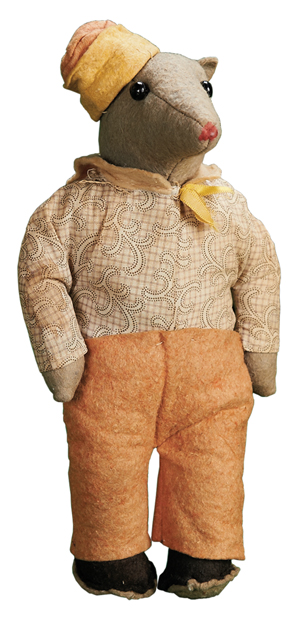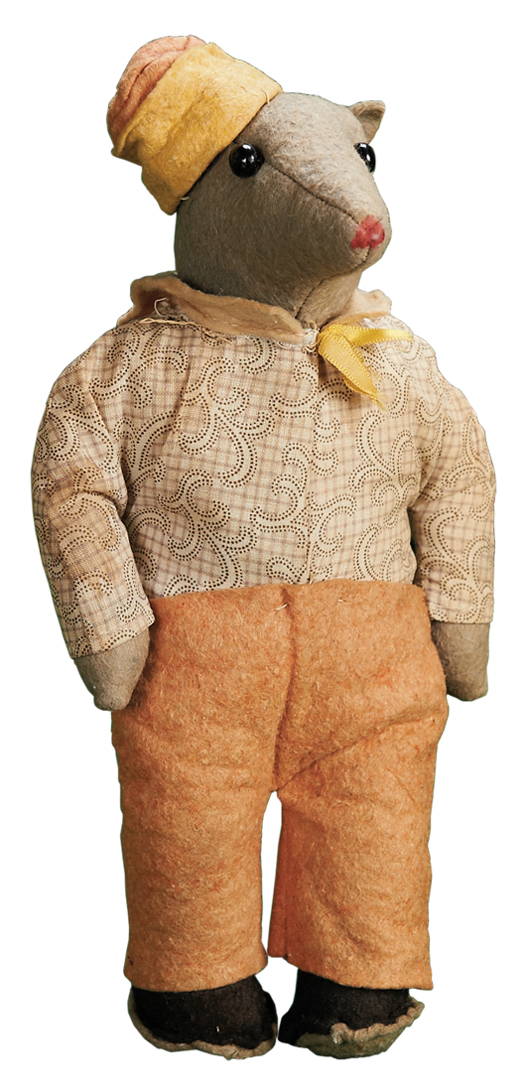
Toys often were made to resemble famous people or characters in plays, books or TV shows. Sometimes the character that inspired the toy is forgotten, but the toy remains popular with collectors because it is so well-designed, unusual or lovable.
Raggedy Ann and Andy are still recognized by young and old, and the storybooks featuring them remain in print. But Johnny Gruelle, who wrote and illustrated the books, created other characters that are forgotten today.
Johnny Mouse and the Wishing Stick is a children’s book published in 1922. It was based on stories and illustrations from Gruelle’s monthly series, Johnny Mouse and the Woozgoozle, which appeared in Woman’s World magazine in 1920 and 1921.
The Johnny Mouse felt doll was patented in July 1921. The magazine sold it by mail order for $1. The gray felt mouse has a long pointy pink nose, shoe-button eyes, one ear and a yellow hat that covers the missing ear. The mouse’s body was dressed in a printed shirt, felt trousers, a yellow neck bow and felt shoes. His clothes could not be removed. The identification of the mouse doll as a design by Gruelle added to the value when the 10-inch doll sold at a Theriault’s auction in Anaheim, Calif., in July 2011. It cost the new owner $1,024.
Q: I bought a pair of metal candle sconces at a recent estate sale because they looked interesting. I bought them for a buck each. When I came home, I realized that the word “Wilton” is stamped on the backs. Each has two candleholders below a flat circular piece decorated with a curved-line cross, hearts, circles and a scalloped border. I’d like to know more about Wilton and the value of these sconces.
A: The Wilton family established its first metal manufacturing company in Wrightsville, Pa., in 1892. Wilton Products was founded in about 1935. It produced candleholders, bottle openers, garden plaques, mechanical banks, trivets, wall decorations and other decorative items at plants in Wrightsville and Santa Barbara, Calif. Wilton Products closed in 1989, but some of its products have been reintroduced by Wilton Armetale, another Wilton company. The curved-line cross on your sconce is called a “lauburu” or “Basque cross.” Value: about $50 for the pair.
Q: I own 35 collector plates I bought in the 1980s from the Bradford Exchange. Some are decorated with copies of Norman Rockwell paintings. I must have spent a total of about $1,000 on them. How do I go about selling them?
A: Unfortunately for you and a lot of people who bought collector plates, the value of these plates has plummeted during the past 30 years. The plates are being offered online for $10-$15 each, but many sell for even less.
Q: My parents bought an ornate revival-style dining room buffet, server, table and chairs during the Depression. The buffet and server have labels that read: “Rockford Republic Furniture Co., Rockford, Ill.” All the pieces except the 10-legged table are in good shape. What do you think the set is worth?
A: From the 1890s until the Depression, Rockford was home to a boom in furniture manufacturing. Rockford Republic Furniture Co. was founded in 1917, when it took over the factory of the bankrupt Rockford Frame & Fixture Co. J.A. Carlstrom, an employee of the fixture company, headed up the group that started the new company. You are better off selling your set locally because of the cost of moving furniture. Rockford Republic furniture is well-made, so you might be able to sell the set for several hundred dollars, even if the buyer has to refinish the table.
Q: My blue-and-white plate looks like early Canton ware, but it’s marked “Made in China” in red on the back. Does that help tell when it was made?
A: Dishes made for export in or near Canton, China, are well-known collectibles. The earliest pieces were made in the 18th century. They were decorated with a drawing of a scene that included trees, a pagoda, a lake and other Chinese figures. They have a “spear and dart” border. This design is still being made. The dishes were exported for many years, stopping only during the Opium Wars of 1840-1860. Your plate was made after 1921, the year the name of the country of origin was first required on dishes shipped into the United States. Red seems to have been the color most often used for the mark.
Tip: Do not use anything but a very soft pencil to label pictures or papers.
Take advantage of a free listing for your group to announce events or to find antique shows and other events. Go to Kovels.com/calendar to find and plan your antiquing trips.
Terry Kovel answers as many questions as possible through the column. By sending a letter with a question, you give full permission for use in the column or any other Kovel forum. Names, addresses or email addresses will not be published. We cannot guarantee the return of any photograph, but if a stamped envelope is included, we will try. The volume of mail makes personal answers or appraisals impossible. Write to Kovels, Auction Central News, King Features Syndicate, 300 W. 57th St., New York, NY 10019.
CURRENT PRICES
Current prices are recorded from antiques shows, flea markets, sales and auctions throughout the United States. Prices vary in different locations because of local economic conditions.
The Fireside Cook Book, by James Beard, 1,217 recipes, 400 color pictures, 322 pp., Simon & Schuster, 1949, $20.
Fun Maker Funny Faces set, six cardboard masks, interchangeable mouths, noses, ears, eyes and eyebrows, original box, Saalfield Publishing Co., Akron, Ohio, 1954, 14 x 11 inches, $35.
Cisco Kid mustache, black, radio premium, WROL, Boston, heavy paper, 1940s, 7 inches, $45.
Red Riding Hood hot water bottle, doll head, red, rubber, marked “Made in England by Dunlop,” $65.
Clark Candy Bar boy figurine, smiling, blue and orange striped shirt, holding candy bar in one hand and pointing to it with other, rubber, 1950s, 8 x 4 inches, $115.
Wicker hamper, tapered sides, two handles, separate lid, 1930s, 26 x 17 1/2 inches, $125.
Cut glass compote, cut rays on base, flowers and leaves cut around bowl, six-sided stem, 1900s, 6 inches, $135.
Peters & Reed art pottery jug, brown glaze, applied grape clusters and leaves around top, 5 3/4 x 5 inches, $150.
Planters Mr. Peanut salt and pepper shakers, beige porcelain, rhinestone monocle, holding cane, “S” and “P” embossed on black top hats, 1958, 4 1/2 x 2 inches, pair, $155.
Country-style coffee table, maple, drop leaves, pull-out arm supports, four legs, pad feet, circa 1920, 19 x 50 inches, $425.
New! The Kovels.com website’s Premium Content is up and running. In addition to 750,000 free prices for antiques and collectibles, many with photographs, premium subscribers will find a dictionary of marks for silver and another for ceramics, with pictured marks and company histories. Premium membership also includes a subscription to the digital edition of our monthly newsletter, “Kovels on Antiques and Collectibles,” and its archives, where you’ll find articles about almost anything you might collect. Up-to-date information for the savvy collector. Go to Kovels.com and click on “Subscriptions” for more information.
© 2012 by Cowles Syndicate Inc.
ADDITIONAL IMAGE OF NOTE


